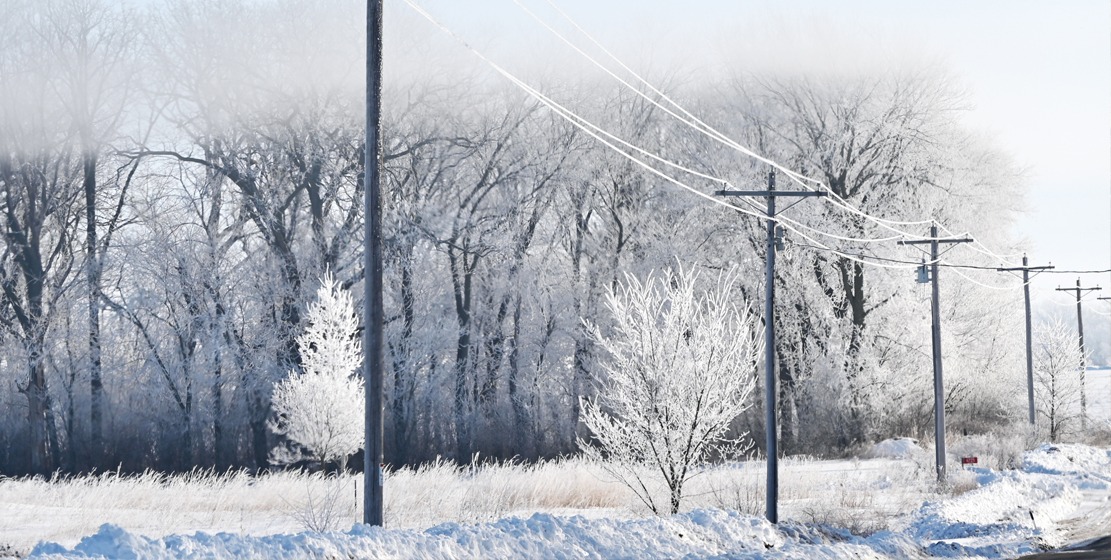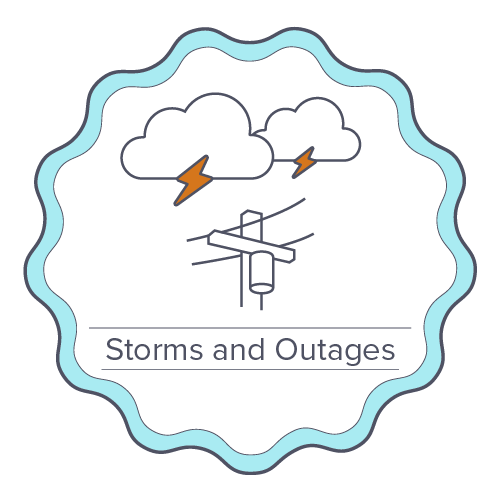We work each day to provide our customers with the safest, most reliable power possible with investments meant to create a stronger, smarter and more resilient electric grid. We also clear vegetation near our power lines, replace and upgrade aging equipment and install the latest grid technology.
But even with the best preparation and information, storms and severe weather can cause damage and result in power outages. With the arrival of the winter season and the potential for ice and snowstorms that can cause outages, please take some time to make sure you’re prepared if you lose power.
Storm preparation
Here are some things you can do to be prepared:
- Make a plan: Whether at home or work, develop an emergency plan involving each person at your location so you’ll know how and where to meet, how you will contact each other and what to do in different situations.
- Be prepared: Prepare an emergency kit, including non-perishable food, water, medication, first aid supplies and any pet supplies you may need. Be sure to include batteries and battery-operated flashlights. Store your emergency kit in one location, preferably in an airtight container. Charge your phones and other devices before severe storms.
- Stay informed: PPL Electric Utilities uses several ways to communicate with customers before storms and during emergencies. Customers can sign up for alerts at pplelectric.com/alerts. Alerts can be customized based on your preferences, including phone, email, or text message. If an outage does occur, customers can get outage alerts and updates on our website at www.pplelectric.com/outage. Adjust alert preferences to receive a phone call, text or email at pplelectric.com/alerts to stay informed during a storm. Be sure to sign up for local emergency alerts and stay tuned to the weather forecast.
- Stay charged: When storms are in the weather forecast, charge your phones and other devices in advance of a storm so they are fully powered.
Power outage safety
If you lose power and experience an emergency situation, call 911. Follow these tips for staying safe during power outages:
- Don’t use candles. Avoid using candles for lighting because they can start fires. Use flashlights instead.
- Keep warm air in. Use your doors as infrequently as possible, and close off unoccupied rooms.
- Keep those doors closed: Avoid opening your refrigerator and freezer as much as possible.
- Don’t use ovens or ranges to heat your home.
- Unplug sensitive home electronics. Turn off ovens and space heaters that may have been on when the outage occurred.
- Keep generators far from buildings. Don’t operate them in confined spaces, such as garages.
- Stay away from any downed wires. Always assume fallen power lines are live and carry electricity. Report downed wires by calling 1-800-DIAL-PPL.
Winter energy savings
There are some easy, inexpensive things everyone can do to save energy and money during frigid temperatures.
- Leave your curtains and blinds open. During the day, capture the sun’s light and heat to gain warmth from the sun. At night, close your curtains and blinds to prevent that free heat from escaping.
- Prevent fireplace heat loss. Keep the damper closed when you’re not using your fireplace so warm air doesn’t escape through the chimney. Energy-efficient fireplace grates also help you save by pulling cool air out of your room and into the fireplace while bringing warm air back into the room.
- Reverse the direction of your ceiling fans. Yes, fans can also keep you warm. Flip the switch to change the direction of the blades so they spin clockwise and pull warm air downward.
- Winterize windows and doors. Inspect all your doors, windows and ductwork for gaps that could leak heat from your home. Many of these cracks and leaks can easily be fixed with caulk and weatherstripping.
- Adjust your thermostat. When you’re home and awake, set the heat as low as it feels comfortable. Aim for 68 degrees as an optimal temperature. Wearing warmer clothing or grabbing a blanket can help keep you cozy. While you’re sleeping or out of the house, lower the thermostat by 10 to 15 degrees. Lowering the thermostat for at least eight hours can save up to 10% on your heating bill. A programmable thermostat will make it even easier to save.
The winter can be unpredictable and unforgiving, but our team is always ready to respond, and our employees are committed to keeping you safe and warm this winter.
Additional Resources and Information



i am surprised at the comment to lower the thermostat 10-15 degrees at night. seems to me that next morning, the heater would then be operating on auxiliary heat until it would get back to normal. auxiliary heat is expensive; i found out the hard way.
Hola quiero pagar la luz
My mother always told us to fill buckets and bathtubs with water as you can flush toilets with a bucket of water. I always do this before a storm.
We need help to pay for our ppl payment before the snowstorm come please help use I have kids
Good afternoon Jennifer, Please know you can pay your bill by texting PAY to 898775, under http://www.pplelectric.com/paybill or using our automated system when calling 1-800-342-5775. If you are referring to Assistance programs to help pay your bill, read more & apply under http://www.pplelectric.com/billhelp.Thank you!
How is the payment process
Were do I send my rewards letter for Social Security to you guys? Can you send me another link so I can take the picture and send it to you?
Good morning Silvio, Any documentation we are requesting needs to be faxed to us at 484-634-3484 with your account & phone number referenced. Thanks!
There is not power??? How long this is going to last
Good morning my name is Jay you turn my electric off yesterday with no shut off notice or nothing I got it hooked up for your guys to come today and you’re not going to even come today why did you turn my electric off in the winter time this is my first account I want my electric on now I want to sue you
Good afternoon Jabbar, We are sorry to hear about your circumstances. Terminations and agreements to reinstate your electric service is exclusively provided through Customer Service at 1-800-342-5775 available weekdays 8am-5pm. Thanks.
Turn my electric off I want it on now I’m going to sue you because you shouldn’t have turned it off I don’t have no bill somebody call me 717-844-7470 I got everything hooked up yesterday but you always been assholes didn’t tell me what time you going to turn my electric on
Good